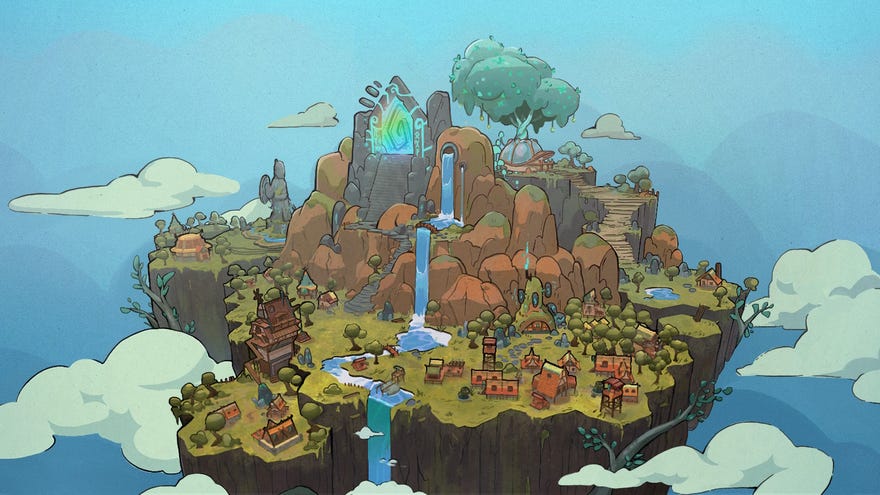Roots Of Yggdrasil's gorgeous roguelike citybuilding is a real grower
It's heading to early access on January 24th
Back in the depths of 2023's February Steam Next Fest, Roots Of Yggdrasil was one of a handful of games that really caught my attention. Not because it was another beautiful-looking deckbuilder (though that does seem to be a steadily growing niche of mine these days), or because its colourful, inkwash visuals had the air of a Norse-flavoured Okami about them (though it did also help). Rather, it was the way its roguelike foundations meshed with its freeform, but still very goal-driven turn-based building systems, giving you drive and purpose in your construction choices, while also being light and chill, with just the right amount of existential threat nipping at your heels.
It struck me that if, say, my best puzzle strategy bud Dorfromantik was ever turned into a roguelike, this is probably a good approximation of what it would look and feel like, which is, frankly, yep, I'd like that game right now, please. Happily, with Roots Of Yggdrasil now approaching its early access launch on January 24th, I'm very happy to report that it's come on leaps and bounds since that Next Fest demo. This is already a very moreish and polished building game, and I've been struggling to tear myself away from it as I guide my longboat of magic Vikings away from their impending Ragnarok.
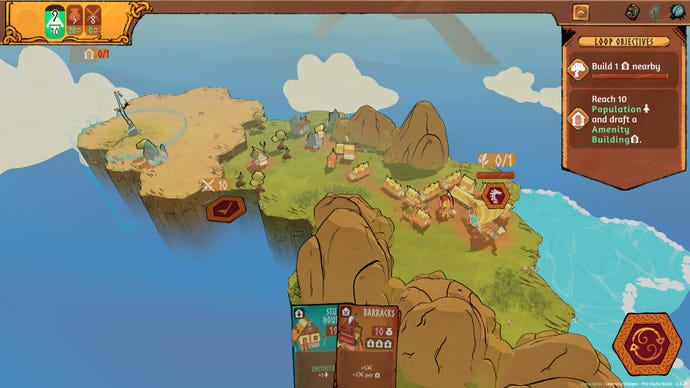


If you've played The Banished Vault or the now sadly cryogenically frozen Jumplight Odyssey, the fundamental structure of Roots Of Yggdrasil will feel intimately familiar, as your band of warriors are forever trying to outrun the all-consuming Ginnungagap, the primordial void from Norse myth. The only way to stay ahead of its fatal purple clouds is by briefly touching down on fragmented floating islands and building up settlements so you can tap the local Yggdrasil tree roots for a much-needed top-up of magic longboat juice (aka: seeds). Then, once you've got enough power to leg it over to the next island, you up sticks and keep on running, all the way up to the top of the Yggdrasil tree.
You've only got a set number of turns to grab your seed stash, however, and the more time you spend on an island, the more unstable the landscape becomes. The timeline bar across the top signals when certain "events" will start happening, but you don't know what they're going to be until they happen. During my time with the early access build so far, these have ranged from flooded tiles to thick, nasty brambles that I need to get rid of, and even storms that gradually cruise across the map, stopping you from building on affected tiles.
The aim, of course, is to get in and get out before this all starts happening, as your timeline also indicates when the Ginnungagap will catch up with you - and that you definitely want to avoid. When "The Gap" turns up, it will gradually spread its fatal smog all across the map, eating up your buildings and their associated bonuses, and when it reaches your ship, it's game over. Well, the end of that run at least, as death will see you whisked back to your hub home, The Holt. Here, you can spend Acorns that you've collected on upgrading your building types and earning extra buffs and leader bonuses, as well as learn more about key characters from your crew as you gradually unlock new Kinships with them. Then it's back out for another run, or "loop" in the game's vernacular, as your Vikings are technically stuck in an endless timeloop - and it's only by reaching the top of the Yggdrasil tree itself that they'll find the answers to try and break out of it. A bit like the excellent Cobalt Core, in other words - though I've yet to survive long enough to do a complete run at the moment, so who knows what's up there.
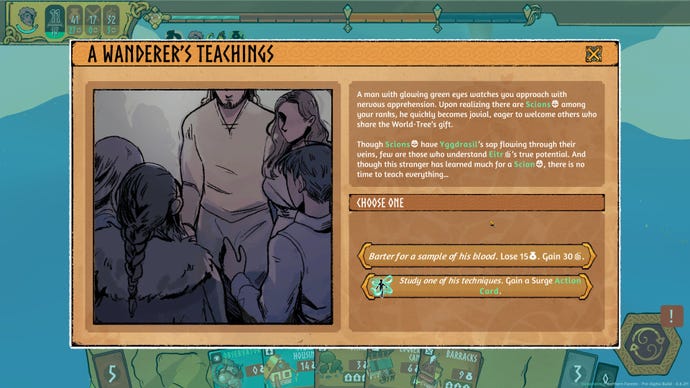

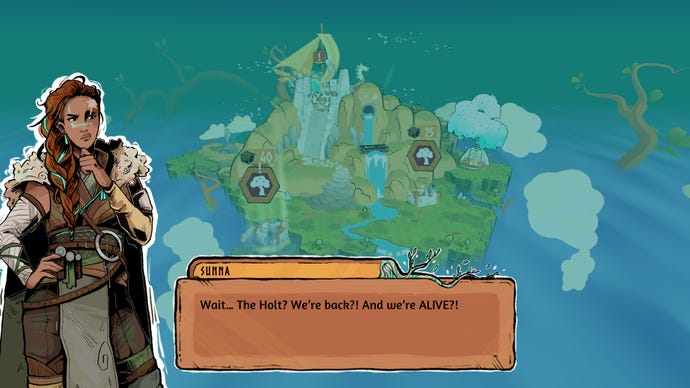
Still, it's a neat narrative device, and one that works well within for Roots Of Yggdrasil's setting. And really, it's just a good excuse to play level after level of its moreish building puzzles. As mentioned earlier, your goal on each island is to build up your town toward the titular roots poking out of the ground. They're often stranded on separate chunks of land from your initial starting position, but accumulate enough Might and your warriors can magic up more terrain to help bridge the gaps. Might comes from plonking specific buildings down such as a Barracks or Training Ground, though these have their own requirements to fulfil as well, such as being in range of a certain number of houses, say, or having two supply buildings nearby and a tavern. New cards are added to your deck by hitting population milestones, but the cost of each new house increases with each one you build, so you'll need to place down enough supply buildings and maximise their refresh bonuses in order to your economy in check and make the most of your deck.
It's a winning formula, and one that really makes you think about the placement of your buildings. For instance, you can't just lay down two Waterwells within range of each other to double up on the initial bonus you gained. They've got to have their own distinct catchment areas. Likewise, any bonuses you might get to help bolster your Supply, Might or magical Eitr reserves can only be gained from buildings already on the map, not the ones that are built near it afterwards. As such, the order in which you play your cards is important, as you might miss out on a vital multiplier otherwise. At the same time, though, you've only got so many supplies you can spend on buildings per turn, and so maximising your hand and keeping your population growing quickly becomes quite the satisfying juggling act. Best of all, you get to decide where all of your buildings go, too, as you can drag and drop them onto the map with your mouse, and fiddle about with their pixel-perfect locations to get their bonus ranges just right.
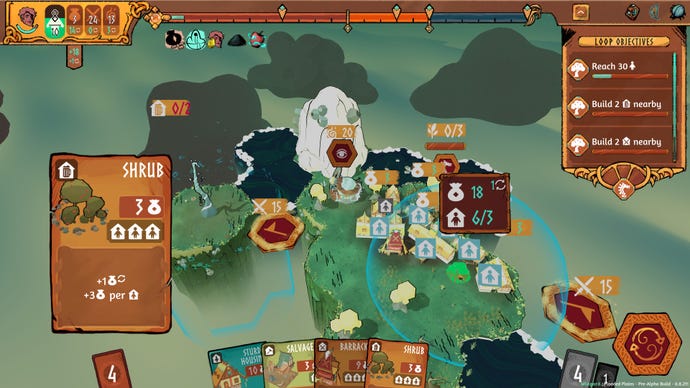
And yes, while you are under a bit of time pressure, the turns themselves last until you hit the big 'End Turn' button in the bottom right corner, giving you plenty of headspace to consider your options. That said, there have been a couple of times where I've felt some unfair rugpulls during my journey. Not such much from the cards themselves (though I have fallen foul of having too many in my deck at times, which can slow down the frequency of obtaining particular cards), but from the way Roots Of Yggdrasil's procedurally generated islands sometimes handle their exploration. For instance, I'll be quite merrily making progress toward a particular Yggdrasil root, spending my Might on the special scouting tiles that are seemingly heading in the root's direction, only to find the actual route to that, err, root, starts somewhere completely unexpected.
In its defence, most of the time it's reasonably obvious which scout tiles will take you to which root. But the biggest kick in the teeth for me came when I landed on a big rocky Dwarven stronghold map, with two trees lying ahead to my right and a third right in front of me behind a big gate. I didn't have the right cards to make the gate open, but no problem, I thought, I only need to reach two roots in this level, so I'll go after the other ones. Exploration takes time, you see, and you'll often need to wait two or three turns for paths to open up. So I make pump my points into the one that looks to be heading toward both, only to effectively run out of track after reaching the first one. As it turns out, the requisite exploration tile to reach the other tree a literal stone's throw away from me was actually behind my starting settlement, with a whole other snakey bit of land bobbing up from beneath the clouds when I eventually unlocked it.

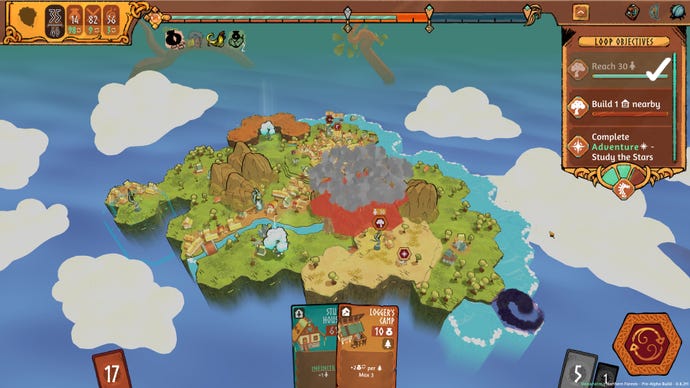
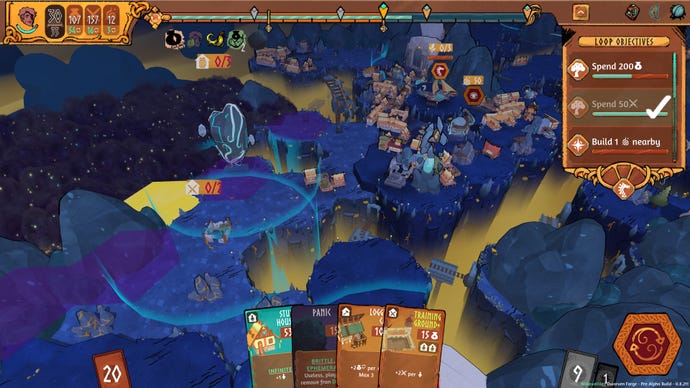

Part of this, I'll admit, is my own fault. I should have been more proactive with building up my Might and exploring multiple routes simultaneously. But when the procedural nature of its map become more difficult to predict and strategise against, there's an inevitable friction that occurs that can really end up souring a particular run. And yes, I did die on that Dwarven stronghold, and I wasn't able to mind "The Gap".
Still, it's not like this has happened so often that I'd consider it a major problem or anything - such is the nature of roguelikes and all that - and I have every hope that its stint in early access will help iron out some of these procedural kinks over time. Developers ManaVoid Entertainment estimate they'll spend around six months in early access at time of writing, putting it roughly in a late June, early July kind of timeframe for a full release, but this may change depending on player feedback, they say. Even so, what's here is already eminently playable, and I'm looking forward to spending more time with it over the coming weeks and months.
